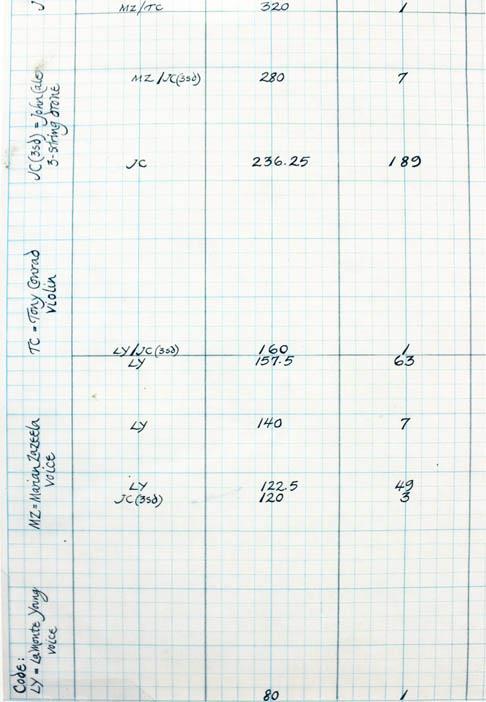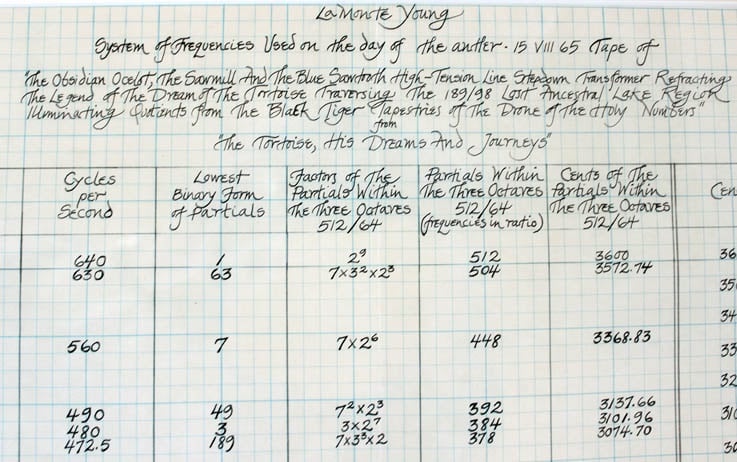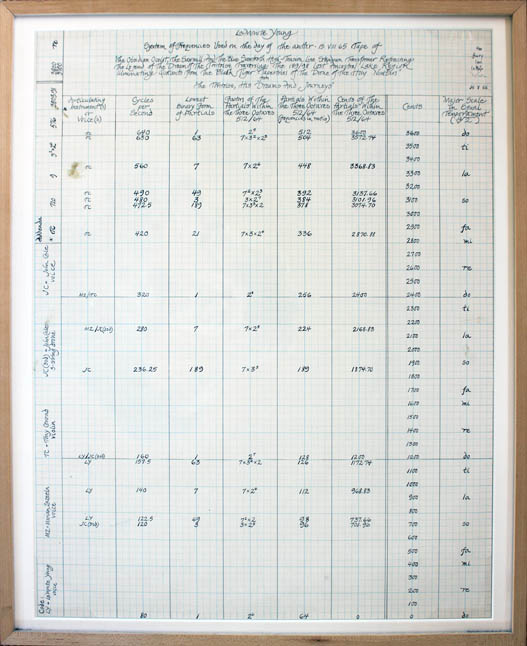

Theatre Of Eternal Music
1965, August 15th
Unknown, New York, NY
“The Tortoise, His Dreams and Journeys”
45:37 miunutes - Broadcast on WKCR-FM in 1984
Viola – John Cale
Violin – Tony Conrad
Vocals – La Monte Young, Marian Zazeela
 |
 |

The following from www.beatbooks.com which sold the manuscript:
The Day of the Antler 15 VIII 65 Tape of "The Obsidian Ocelot, The Sawmill and The Blue Sawtooth High-Tension Line
Stepdown Transformer Refracting The Legend of The Dream of The Tortoise Traversing The 189/98 Lost Ancestral Lake
Region Illuminating Scenes from The Black Tiger Tapestries of The Drone of The Holy Numbers" from "The Tortoise, His
Dreams And Journeys".
Original manuscript music score, transcribed in black ink calligraphy by Marian Zazeela, corresponding to an improvisatory
performance by the Theatre of Eternal Music recorded on August 15, 1965 at Young and Zazeela's loft in New York City.
Large sheet of graph paper (56x44cm.), divided into nine columns, forming a chart providing information about the frequencies
and partials used, and listing the performers, La Monte Young (voice), Marian Zazeela (voice), Tony Conrad (violin), and John
Cale (3-string drone and voice), each of whom are indicated by name in the left-hand margin, and by initial in the first column,
'Articulating Instrument(s) or Voice(s)'.
SIGNED and inscribed in black ink in the top right-hand corner to Henry Flynt: "for Henry love la Monte 26 V 66" and (in pencil)
"Marian". Flynt, an artist, philosopher and musician associated (though unaffiliated) with the Fluxus movement, first met Young in
1960, who dedicated his composition "X for Henry Flynt" to him in the same year.
The score, written out after the tape was recorded, is the only one for a Theatre of Eternal Music recording known to exist. It was
transcribed as part of La Monte Young's application for a Guggenheim Fellowship (which called for a submission of a musical
score), and it would seem likely that he presented it to Flynt once his Fellowship had been successfully granted. Years later, in an
essay in which he reaffirmed his status as the Theatre of Eternal Music's sole composer (a claim contested by Tony Conrad and
John Cale), Young wrote that "The score was probably written out sometime in November 1965", and that "A photostat of the score
was mounted and hung on the wall at our Church Street studio in plain view for many years" (Notes on The Theatre of Eternal
Music and The Tortoise, His Dreams and Journeys, 2000).
The composer and music critic for The Village Voice, Kyle Gann, has documented the score ("Sound and Light: La Monte
Young/Marian Zazeela", Bucknell Review Vol. XL, No. 1, 1996), and Keith Potter included an analysis and illustration of it in his book,
"Four Musical Minimalists" (Cambridge University Press, 2000). It was acquired by its previous owner more than twenty years ago
from the art dealer Steven Leiber (author of "Extra Art: A Survey of Artists' Ephemera, 1960-1999"), who it is believed originally
purchased it from a private collection in Germany.
Faint central vertical and horizontal folds; two marks to upper left section, not obscuring text; o/w Near Fine. Attractively mounted and
wood-framed behind UV acrylic to museum level by Fletcher Gallery Services of London.
A rare and important score by La Monte Young, one of the most influential composers of the twentieth century, whose early
experiments with long tones led to the development of minimalism, notably the compositions of Terry Riley, and whose work with the
Theatre of Eternal Music directly influenced the Velvet Underground.